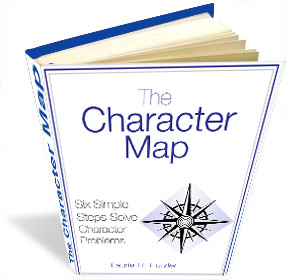
Here’s How The Character Map Improved My Writing
When I began writing movies, I had a hard time getting to the 90-pg. mark. My scripts were tight, well edited, and well structured. However, they were too short. I thought of it as a length problem at the time. I felt that I needed to come up with more ideas.
 I was looking for that hidden gem somewhere in my clever writer’s mind, a treasure that I could uncover and, in turn, share with the world. But the issue with my writing was emotional, not intellectual.
I was looking for that hidden gem somewhere in my clever writer’s mind, a treasure that I could uncover and, in turn, share with the world. But the issue with my writing was emotional, not intellectual.
I couldn’t afford “The Character Map” book when I first came across it. I didn’t even have room in my budget to eat more than peanut butter and jelly sandwiches every day and simple meals cooked at my apartment.
When I finally bought and read the book, I learned about myself in each of the six areas described on the map. For example, I wore a mask when I was around the girl who I was dating. I also realized how my brother’s gift of encouraging people that I wanted was already a nascent seed in myself. And I had a fear of being considered unlovable. True feelings don’t always feel good. But they are true, and a true foundation is the only kind that can be built on successfully.
I felt that I couldn’t focus on the principles that I was learning in the book at first. They brought up emotions about my self that seemed to distract at the time. The book’s character insights were helping me to face my true self, as I acknowledged the feelings that I had buried deep down because of pain I experienced in the past. Interestingly, I periodically met with a counselor during this same season of my life. The Character Map allowed me to take what I was learning about the depths of my self and to understand that characters on the screen could be just as complex.
At first, it was an exercise to think through the different aspects of the Character Map. I asked myself the questions outlined: what is my character’s mask? Greatest fear? Dark side? In time, I was pleasantly surprised how my characters began to come alive on the page.
The best moments in the new draft of my script were no longer the clever moments, carefully crafted with smarts (my “strongest trait,” as the character map describes it). Now there was a new layer to my script. It came out of my instincts, my emotions. And with practice, less of my emotion was stopped up between my initial gut instinct and the character’s lines and actions on the page. My characters began to express their passions, becoming alive and active in my imagination. The mask over my True Self began to crack, breaking apart.
I was given a way of structuring the emotions that I gave my characters. The Character Map gave me a way of charting my course, marrying the craft of screenwriting with the characters’ raw, uncharted desires.
As I have continued to grow as a screenwriter, I have applied the questions of the Character Map. They are ingrained in my process. And with my most recent screenplay, I have found that my characters are both bursting with emotion and acting according to a logic that is consistent with their personalities. There is a freedom in charting the depth of a character (their mask, their fears, etc.) because this depth of understanding allows me to improvise my characters’ actions in a scene. Knowing my characters as well as I now do, I can imagine with clarity what it is they might do in the situations that they are in.
“The Father” is the most recent film that I have written, and after eight feature-length screenplays, it is resonating with its readers in a deeply emotional and meaningful way. The main character, Jack, wakes up on a public sidewalk, wondering how he got there. He realizes that he has lost his memory. He wants to get back home. So much of this story takes place in Jack’s head, as he remembers, so there is a danger of losing the audience with the meticulous nature of putting the expositional puzzle pieces together.
However, with the Character Map questions there becomes an opportunity for writing a character that is so deeply known by the audience that the story can turn with the rising or diminishing of his greatest fear.
There is also the new and dynamic nature of an antagonist who has his own character map. This character is no longer a “bad guy,” with two or three dimensions at best, he is now a full-fledged and intricate enigma with his own greatest fear, weakness, strongest trait, and of course, a dark side. As Hitchcock said, “If I have a great antagonist, I can make a hero out of a milquetoast.” This is crucial to writing a great character-driven film.
The minimalist screenplay that I am now writing tracks the inner journey of a character with success. The antagonist can now affect the protagonist by bringing out the protagonist’s greatest fear. The protagonist can be hindered in his quest by his own strongest trait. And so a whole host of wild and engaging possibilities arise that I couldn’t have hoped to wrangle in before.
The bottom line is that the emotion of my characters is colored vibrant on the page by their masks, fears, traits, and dark sides. The short film version of my project is impressing readers, the premise is holding the attention of strangers, and the concept trailer just released is getting emotional responses and audiences are watching it multiple times because of its intriguing characters.
The intricacies of a character — living or fictional — can be mesmerizing. The Character Map has helped lead me to those hidden gems somewhere in my writer’s heart, a treasure that I can uncover and, in turn, share with the world.
Evan Atwood is an award-winning filmmaker and screenwriter, who lives in Milwaukee, WI and works as a photojournalist to pay the bills. He has written, produced, and directed the short films “Forgiven,” and “The Neighbor,” which have both won awards for excellence. He is currently developing his first feature-length film, “The Father” (igg.me/at/thefatherfilm).
Links to short films:
“The Neighbor” — https://youtu.be/9RozideZw-s
“Forgiven” — https://youtu.be/gwPtvDM2a_0
Fund Raising for The Father – igg.me/at/thefatherfilm






No comment yet, add your voice below!